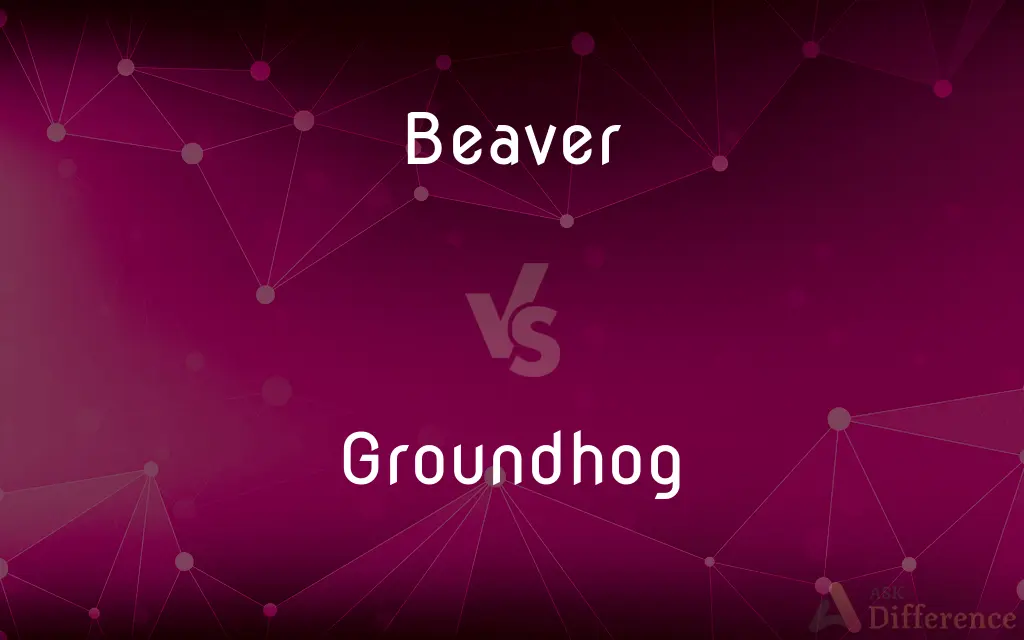Beaver vs. Groundhog — What's the Difference?
By Tayyaba Rehman & Fiza Rafique — Updated on March 15, 2024
Beavers are large, semiaquatic rodents known for building dams, whereas groundhogs, smaller and terrestrial, are notable for their burrowing habits.

Difference Between Beaver and Groundhog
Table of Contents
ADVERTISEMENT
Key Differences
Beavers are distinguished by their large size, webbed hind feet, and broad, flat tails, which they use for swimming and building. They are primarily nocturnal and excel in aquatic environments, where they construct impressive dams and lodges as part of their habitat. These structures play a crucial role in wetland ecosystems, aiding in water purification and providing habitats for various species. On the other hand, groundhogs, also known as woodchucks, are members of the squirrel family and are best known for their burrowing activities. Unlike beavers, groundhogs are diurnal and spend much of their time on land, although they can swim if necessary. They dig extensive burrow systems for shelter, hibernation, and rearing their young.
Beavers are also herbivorous, feeding on tree bark, leaves, and aquatic plants. Groundhogs are also herbivorous, but their diet primarily consists of grasses, fruits, and vegetables. They are often found in open fields, woodlands, and along the edges of forests.
While beavers impact their environment by altering water flow and creating wetlands, groundhogs' burrowing can affect soil structure and vegetation. Both species, however, play important roles in their respective ecosystems, contributing to biodiversity and ecological balance.
The social structures of beavers and groundhogs also differ. Beavers live in family units called colonies, demonstrating complex social behaviors and cooperative work, especially in dam and lodge construction. Groundhogs, in contrast, are more solitary, with adults usually living and foraging alone except during the breeding season.
Despite their differences, both beavers and groundhogs have adaptations that enable them to survive and thrive in their environments. Beavers have sharp incisors that grow continuously, allowing them to gnaw on wood without wearing down their teeth, while groundhogs have powerful limbs and claws for digging.
ADVERTISEMENT
Comparison Chart
Habitat
Aquatic environments, builds dams and lodges
Terrestrial, digs burrows
Size
Larger, up to 60 lbs (27 kg)
Smaller, up to 14 lbs (6.3 kg)
Activity Time
Nocturnal
Diurnal
Diet
Tree bark, leaves, aquatic plants
Grasses, fruits, vegetables
Social Structure
Lives in family units (colonies)
Solitary, except in breeding season
Compare with Definitions
Beaver
Large, semiaquatic rodent.
The beaver used its strong teeth to cut down the tree for its dam.
Groundhog
Weather predictor (folklore).
According to folklore, the groundhog’s behavior on Groundhog Day predicts the arrival of spring.
Beaver
Herbivorous.
Beavers mainly eat tree bark and aquatic vegetation.
Groundhog
Burrower.
Groundhogs create extensive underground homes that can have multiple exits.
Beaver
Dam builder.
Observing a beaver building a dam is a fascinating glimpse into animal engineering.
Groundhog
Herbivorous.
Groundhogs feed on a diet of grasses and garden vegetables.
Beaver
Social creature.
Beavers live in colonies and work together to maintain their dams and lodges.
Groundhog
Small, terrestrial rodent.
The groundhog emerged from its burrow in early spring.
Beaver
Aquatic ecosystem engineer.
Beavers play a crucial role in creating wetlands that benefit many species.
Groundhog
Solitary.
Apart from the breeding season, groundhogs prefer to live and forage alone.
Beaver
Beavers are large, semiaquatic rodents in the genus Castor native to the temperate Northern Hemisphere. There are two extant species: the North American beaver (Castor canadensis) and the Eurasian beaver (C. fiber).
Groundhog
The groundhog (Marmota monax), also known as a woodchuck, is a rodent of the family Sciuridae, belonging to the group of large ground squirrels known as marmots. The groundhog is a lowland creature of North America; it is found through much of the eastern United States, across Canada and into Alaska.
Beaver
Either of two large semiaquatic rodents, Castor canadensis of North America or C. fiber of Eurasia, having thick brown fur, webbed hind feet, a broad flat tail, and sharp incisors used for gnawing bark and felling trees, with which they construct dams and underwater lodges.
Groundhog
Another term for woodchuck
Beaver
The fur of a beaver.
Groundhog
See woodchuck.
Beaver
A top hat originally made of the underfur of a beaver.
Groundhog
A red-brown marmot, Marmota monax, native to North America.
Beaver
A napped wool fabric, similar to felt, used for outer garments.
Groundhog
(rare) The aardvark.
Beaver
Vulgar Slang The female genitals.
Groundhog
A reddish brown North American burrowing marmot (Marmota monax), also called the woodchuck. It hibernates in the winter.
Beaver
Offensive Slang A woman or girl.
Groundhog
Reddish brown North American marmot
Beaver
The visor on a helmet.
Beaver
Of or relating to a beaver or beavers
Beaver fur.
A beaver hat.
Beaver
Constructed by beavers
Beaver dams.
Beaver
To work diligently and energetically.
Beaver
To spot a beard in a game of beaver.
Beaver
To work hard.
Beaver
To cut a continuous ring around a tree that one is felling.
Beaver
(backgammon) After being doubled, to immediately double the stakes again, a move that keeps the doubling cube on one’s own side of the board.
Beaver
(countable) A semiaquatic rodent of the genus Castor, having a wide, flat tail and webbed feet.
Beaver
The fur of the beaver.
Beaver
(countable) A hat, of various shapes, made from a felted beaver fur (or later of silk), fashionable in Europe between 1550 and 1850.
Beaver
(North American) Beaver pelts as an article of exchange or as a standard of value.
Beaver
Beaver cloth, a heavy felted woollen cloth, used chiefly for making overcoats.
Beaver
A brown colour, like that of a beaver.
Beaver
A move in response to being doubled, in which one immediately doubles the stakes again, keeping the doubling cube on one’s own side of the board.
Beaver
Senseid|en|member of the youngest wing of the Scout movement}} {{alternative case form of Beaver.
Beaver
Senseid|en|part of a helmet}} {{alternative spelling of bevor.
Beaver
An amphibious rodent, of the genus Castor.
Beaver
The fur of the beaver.
Beaver
A hat, formerly made of the fur of the beaver, but now usually of silk.
A brown beaver slouched over his eyes.
Beaver
Beaver cloth, a heavy felted woolen cloth, used chiefly for making overcoats.
Beaver
A man's beard.
Beaver
The hair on a woman's pubic area; - vulgar.
Beaver
A woman; - vulgar and offensive.
Beaver
A person who works enthusiastically and diligently; - used especially in the phrase eager beaver.
Beaver
The soft brown fur of the beaver
Beaver
A full beard
Beaver
A man's hat with a tall crown; usually covered with beaver or silk
Beaver
A movable piece of armor on a medieval helmet used to protect the lower face
Beaver
A hat made of beaver fur or similar material
Beaver
Large semiaquatic rodent with webbed hind feet and a broad flat tail; construct complex dams and underwater lodges
Beaver
Work hard on something
Common Curiosities
How do beavers impact their environment?
Beavers create wetlands by building dams, which help in water purification and habitat provision for various species.
What is the primary difference between beavers and groundhogs?
Beavers are semiaquatic and build dams, while groundhogs are terrestrial and known for their burrowing.
What do groundhogs eat?
Groundhogs primarily eat grasses, fruits, and vegetables.
Can beavers and groundhogs swim?
Beavers are excellent swimmers with adaptations for aquatic life, whereas groundhogs can swim but primarily live on land.
What do beavers eat?
Beavers are herbivores, feeding on tree bark, leaves, and aquatic plants.
Are groundhogs nocturnal or diurnal?
Groundhogs are diurnal, active during the day.
Do groundhogs have natural predators?
Yes, groundhogs are preyed upon by foxes, hawks, and snakes.
How do groundhogs impact their environment?
Groundhog burrowing can affect soil structure and vegetation but also creates habitats for other species.
What is the social structure of beavers?
Beavers live in family units called colonies and exhibit cooperative behaviors.
Do beavers have natural predators?
Yes, beavers' predators include wolves, coyotes, and large birds of prey.
Are beavers nocturnal or diurnal?
Beavers are mostly nocturnal.
How do beavers build their homes?
Beavers build lodges and dams using wood, mud, and stones.
What is the significance of Groundhog Day?
Groundhog Day is a folklore tradition where the groundhog’s behavior is said to predict the coming of spring.
What is the social structure of groundhogs?
Groundhogs are more solitary, except during breeding season.
How do groundhogs build their homes?
Groundhogs dig extensive burrow systems with multiple chambers and entrances.
Share Your Discovery

Previous Comparison
Dispersion vs. Skewness
Next Comparison
Training vs. ConditioningAuthor Spotlight
Written by
Tayyaba RehmanTayyaba Rehman is a distinguished writer, currently serving as a primary contributor to askdifference.com. As a researcher in semantics and etymology, Tayyaba's passion for the complexity of languages and their distinctions has found a perfect home on the platform. Tayyaba delves into the intricacies of language, distinguishing between commonly confused words and phrases, thereby providing clarity for readers worldwide.
Co-written by
Fiza RafiqueFiza Rafique is a skilled content writer at AskDifference.com, where she meticulously refines and enhances written pieces. Drawing from her vast editorial expertise, Fiza ensures clarity, accuracy, and precision in every article. Passionate about language, she continually seeks to elevate the quality of content for readers worldwide.
















































